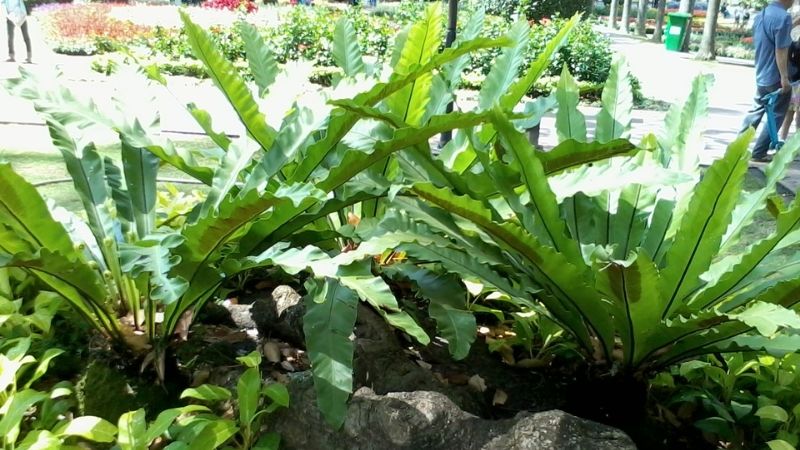The Bird’s Nest Fern, or Asplenium nidus, is more than just an aesthetically pleasing plant—it holds significant feng shui meanings and is believed to possess medicinal properties. Let’s delve into the world of this fascinating plant and explore its origins, symbolism, and care instructions.
1 Unveiling the Bird’s Nest Fern
Origin and Significance of the Bird’s Nest Fern
 Unveiling the Bird’s Nest Fern
Unveiling the Bird’s Nest Fern
Known by various names, including Bird’s Nest Fern, Staghorn Fern, and Crow’s Nest Fern, this plant boasts a scientific name—Asplenium nidus. It belongs to the Aspleniaceae family, commonly known as the spleenwort family.
Bird’s Nest Ferns thrive in vast tropical rainforests, typically found in regions like the Philippines and Australia. In Vietnam, these ferns grace the landscapes of the Western Highlands, Dong Nai, and Lam Dong provinces.
Feng Shui Significance of the Bird’s Nest Fern
The large leaves of the Bird’s Nest Fern form a protective circle around the smaller, more delicate leaves within, resembling a family’s embrace.
Additionally, the Chinese character for “phoenix” in its name alludes to resilience and rebirth, as the mythical bird rises from the ashes. Thus, the fern symbolizes vitality and endurance, weathering harsh rainforest conditions.
 Feng Shui Significance of the Bird’s Nest Fern
Feng Shui Significance of the Bird’s Nest Fern
Characteristics and Classification of the Bird’s Nest Fern
In nature, Bird’s Nest Ferns are epiphytes, deriving moisture and nutrients from the air and rain while growing on tree trunks or rocks. Their leaves sprout from a central crown, forming a distinctive circular shape reminiscent of a bird’s nest.
The leaves are large, wavy-edged, and thick, reaching lengths of 30-80 cm, resembling a peacock’s tail, hence the name “Bird’s Nest.” As a member of the spleenwort family, this fern reproduces through spores on the underside of its leaves, forgoing the typical floral display of most plants.
2 The Multifaceted Benefits of Bird’s Nest Ferns
From a feng shui perspective, the Bird’s Nest Fern symbolizes harmony and warmth within families. It is particularly auspicious for individuals with the Fire and Water elements as their Chinese zodiac signs. For these individuals, the fern brings good fortune in their careers and fosters familial harmony.
3 Cultivating and Caring for the Bird’s Nest Fern
Growing Bird’s Nest Ferns at Home
Bird’s Nest Ferns propagate through spores located on the back of their leaves, arranged in diagonal rows along the midrib. Alternatively, you can divide and transplant established clumps to propagate new plants.
 Cultivating and Caring for the Bird’s Nest Fern
Cultivating and Caring for the Bird’s Nest Fern
Caring for Your Bird’s Nest Fern
The Bird’s Nest Fern is relatively low-maintenance and easy to care for. Here are some tips to ensure its thriving growth:
- Light: While the fern thrives in bright, indirect light, avoid exposing it to direct sunlight for extended periods, and do not keep it in the dark for too long.
- Temperature: This plant flourishes in warm climates like Vietnam’s and does not tolerate cold temperatures well.
- Water: During the summer, water the fern frequently and maintain a humid environment.
- Soil: Bird’s Nest Ferns prefer well-drained, airy soil. Avoid overly fertile soil, as it can lead to root rot.
Important Notes on Growing and Caring for Bird’s Nest Ferns
- If you’re growing the fern from spores and have just noticed germination, water it twice a day for the first month before moving it outdoors.
- Fertilize your fern every four to five months to ensure lush, green leaves.
- Bird’s Nest Ferns are resilient and easy to care for, as long as you provide adequate water and nutrients.
4 Captivating Captures of the Bird’s Nest Fern
 The Bird’s Nest Fern, also known as the Staghorn Fern
The Bird’s Nest Fern, also known as the Staghorn Fern
 Native to regions like the Philippines and Australia
Native to regions like the Philippines and Australia
 Found in Vietnam’s Western Highlands, Dong Nai, and Lam Dong provinces
Found in Vietnam’s Western Highlands, Dong Nai, and Lam Dong provinces
 Bird’s Nest Ferns grow epiphytically on tree trunks
Bird’s Nest Ferns grow epiphytically on tree trunks
 They reproduce through spores on the underside of their leaves
They reproduce through spores on the underside of their leaves
Now you know all about the Bird’s Nest Fern—its origins, feng shui significance, and practical applications. We hope this information proves valuable in your pursuit of knowledge!
2023 Lunar New Year Gift Ideas for Older Family and Friends
As 2021 approaches, families worldwide are gathering to celebrate the special bond between grandparents and their grandchildren. To show their love and admiration, these thoughtfully chosen gifts will bring a smile to the face of the elderly. Here, we have compiled a list of the 13 most meaningful Tet presents that can bring joy to our beloved grandparents.






































